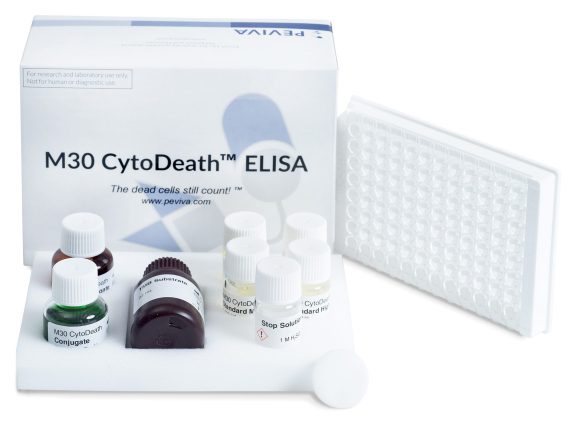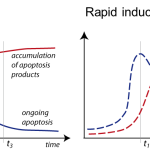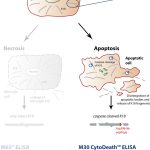
M30 CytoDeath™ CK18 Kit
$0.00
The M30 CytoDeath™ ELISA is a novel research kit developed for cell culture applications. The M30 CytoDeath™ assay has a dynamic range and sensitivity suitable for in vitro work.
M30 CytoDeath™ ELISA is a powerful drug screening tool. It is useful for in vitro characterization of apoptosis-inducing drugs, including establishment of time course kinetics and dose response relationships. The effects of large numbers of siRNAs on apoptosis can be tested in the 96 well format. The assay offers a unique possibility to quantify apoptosis of epithelially derived cells in multicellular spheroids and organ culture systems.
The M30 CytoDeath™ ELISA is based on the M30 antibody (detecting the Asp396 caspase-cleavage site on CK18) and antibody M6. This combination is different from that used in the M30-Apoptosense® ELISA.
The M30 CytoDeath™ ELISA is not suitable for serum/plasma.
Reagents, Packaging, Storage, and Stability
| M6 Coated Microstrips | One microplate, 12 strips with 8 wells each, 96 dry wells in total. The wells are coated with mouse monoclonal K18 antibody M6. The microplate is sealed in an aluminium bag, which contains a desiccating device. If not all the strips are used, reseal the bag and keep the desiccating device inside. Ready for use! |
|---|---|
| M30 CytoDeath HRP Conjugate | Concentrate (24 × conc.). One vial containing 0.4 mL of mouse monoclonal M30 antibody (anti-K18Asp396 neo-epitope) conjugated with horseradish peroxidase (HRP) in a phosphate buffer with protein stabilizers. Preservative added. Should be diluted with M30 CytoDeath Conjugate Dilution Buffer (see Instructions for Use section “Component Preparation” on page 9). Note! Do not expose to light! |
| M30 CytoDeath Conjugate Dilution Buffer | One vial containing 11 mL of phosphate buffer with protein stabilizers for dilution of the M30 CytoDeath HRP Conjugate. Preservative added. Green colored. |
| M30 CytoDeath Standards | Standard Zero containing 0.5 mL of phosphate buffer with fetal calf serum (FCS). Standards Low, Medium and High, 0.5 mL each, containing standard material in a phosphate buffer with FCS. The values of the Standards are 0 U/L (Zero), 250 U/L (Low), 1 000 U/L (Medium) and 3 000 U/L (High). Preservative added. Yellow colored. Ready for use! Standard Zero can be used for dilutions of samples > 3 000 U/L. |
| Wash Tablet | One tablet for 500 mL of prepared wash solution. Dissolve the Wash Tablet in 500 mL of fresh deionised water. |
| TMB Substrate | One bottle containing 22 mL of TMB (3,3’,5,5’-Tetramethylbenzidine) Substrate. Note! Do not expose to light! Ready for use! |
| Stop Solution | One vial containing 7 mL of 1.0 M sulphuric acid. Ready for use! |
| Sealing Tape | One (1) sheet. |
Downloads
- Package Insert (PDF)
- Safety Data Sheet (PDF)
- CofA - Exp: 01/31/2027 (PDF)
- Brochure (PDF)
- Peviva Product Line Overview Brochure - Digital Viewing Format (PDF)
- Apoptosis Detection in Cell Cultures Brochure (PDF)
- CK18 Peviva Product Overview Table (PDF)
- Peviva Product Overview Presentation (PDF) (PDF)
- Peviva Product Overview Presentation (PPT) (PowerPoint)
- Peviva Cell Death Product Range Brochure(PDF) (PDF)
- Peviva Oncology Brochure (PDF)
- Peviva Oncology Flyer (PDF)
- Apoptosis Research (Measurement of an Accumulated Apoptosis-Specific Product) Presentaiton(PDF) (PDF)
- Apoptosis Research (Measurement of an Accumulated Apoptosis-Specific Product) Presentaiton(PPT) (PowerPoint)
- Peviva Oncology Cell Death Products Presentation (PDF)
- Assessing Hepatotoxicity of Compounds Article (PDF)
- Biomarkers ccK18 and K18 in Hepatotoxicity Article (PDF)
- CK18 in Vinyl Chloride-Related TASH Article (PDF)
- Novel Liver and Kidney Biomarkers Tech Bulletin (PDF)
- For in vitro Tumor and Organ Drug Cytotoxicity Testing: High Sensitivity Detection of Apoptosis using M30 CytoDeath ELISA with a Novel Cytoskeleton Solubilisation Buffer (CSB) (PDF)
Videos
Can some components of the Peviva M30 CytoDeath™ ELISA from different lots be mixed or combined?
No, it is strongly advised to use the components of the same lot provided with each kit only as these may affect the consistency of the results obtained.
Some methods measure the late stages of apoptosis. What is known for the Peviva M30 CytoDeath™ ELISA?
The M30 CytoDeath™ ELISA detects apoptosis early on, as opposed to methods that measure DNA fragmentation.
MCF-7 cells are known to be defective in caspase-3 activity. Can I still use the Peviva M30 CytoDeath™ ELISA?
Yes, M30 CytoDeath™ ELISA can be used in cells lacking active caspase-3 as also other caspases, but no other proteases can generate the M30 neo-epitope. Apoptotic MCF-7 cells generate M30-activity due to activity of those other caspases.
Briefly describe the procedure for the Peviva M30 CytoDeath™ ELISA.
Serum samples (25 µl) containing caspase-cleaved K18 (K18Asp396-NE: M30 neo-epitope) bind to an immobilized monoclonal capture antibody specific to K18. HRP-conjugated M30 antibody is added and the plates are incubated for 4 hours. Excess unbound tracer is removed by washing and TMB substrate is added. The reaction is stopped after a defined incubation period and the absorbance is measured in a microplate reader at 450 nm.
Is the Peviva M30 CytoDeath™ ELISA sensitive and robust?
The assay is very sensitive, as it easily detects apoptosis in less than 5 000 carcinoma cells. The stability of the detected K18Asp396-NE M30 neo-epitope makes the assay very robust and reproducible. The established HRP-TMB ELISA method is very reproducible compared to e.g. caspase activity assays that require an optimal reaction buffer, and are sensitive to changes in temperature and substrate concentration.
What kind of samples can be analyzed by the Peviva M30 CytoDeath™ELISA?
As the caspase-cleaved product is released from cells, the antigen is present in the cell culture supernatant as well as in cytosolic cell extracts. Both types of samples can therefore be analyzed individually, or as a combined sample (by direct addition of detergent to the cell culture).
How should samples for the Peviva M30 CytoDeath™ ELISA be stored?
Cell extracts should be frozen at -20°C immediately, if not used within 4 hours.
Does the M30 CytoDeath™ ELISA also detect necrosis?
No. Due to the specificity of the M30 antibody to a caspase cleavage product, the M30 CytoDeath™ ELISA recognizes apoptotic cells only, not necrotic or viable cells.
Can the Peviva M30 CytoDeath™ ELISA be used for all cell types?
No, the M30 CytoDeath™ ELISA can only be used for K18-positive cells (of epithelial origin) e.g. breast, lung, prostate, colon etc. Fibroblasts, lymphocytes, neuronal cells etc. can not be analyzed as these cell types do not express K18.
How specific is the Peviva M30 CytoDeath™ ELISA for apoptosis?
Some methods, such as TUNEL (labeling of double-stranded DNA breaks) do not distinguish between necrotic and apoptotic cells. The M30 neo-epitope on keratin 18 is only exposed after caspase cleavage occurring during apoptosis.
What is the difference and advantage of the Peviva M30 CytoDeath™ ELISA compared to assays that measure e.g. caspase-3 activity?
The caspase-3 assay measures enzyme activity (with specificity problems associated with “peptide caspase”-substrates), while the M30 CytoDeath™ ELISA measures the accumulation of a caspase cleavage product. Due to the accumulation of the analyte (K18Asp396-NE) over time, M30 CytoDeath™ ELISA is more sensitive and does not require consideration of the optimal analytical (often transient) window. This makes this assay convenient and economical when a large number of samples are analyzed. A limitation of the M30 CytoDeath™ ELISA is that it will only work with epithelial cells.
Can the Peviva M30 CytoDeath™ ELISA be used for K18-positive cells from other species than human?
The M30 antibody recognizes caspase-cleaved keratin 18 (K18Asp396-NE M30) from human and monkey cells. K18Asp396-NE from mouse, rat, dog and xenopus cells is not detected with sufficient sensitivity. It is recommended that the presence of K18 is confirmed for the individual test cell line.
What is the advantage of using the Peviva M30 CytoDeath™ ELISA relative to other methods to quantify apoptotic cell death?
The M30 CytoDeath™ ELISA measures a stable and abundant caspase cleavage product. It offers a very high sensitivity and makes it the method of choice for cost effective drug screening at a functional level, to establish dose-response curves and to establish time course kinetics in cellular systems in therapeutic relevant areas as oncology.
What is the mode of action for the Peviva M30 CytoDeath™ ELISA?
M30 CytoDeath™ ELISA is a sandwich ELISA based on two mouse monoclonal antibodies, M30 and M6. The M30 antibody recognizes a neo-epitope in the C-terminal domain of keratin 18 (amino acids 387-396: K18Asp396-NE), exposed after cleavage by multiple caspases during apoptosis. The M6 antibody is used as capture antibody in the ELISA. Caspases that are capable of cleaving K18 to generate this M30 neo-epitope include in addition to caspase-3, also caspase-6, -7, and -9.
What is the intended use of the Peviva M30 CytoDeath™ ELISA?
The M30 CytoDeath™ ELISA is intended for the quantitative detection of the apoptosis-associated M30 neo-epitope (K18Asp396-NE) in cell extracts or cell culture supernatants. Potential applications include HTS screening for apoptotic drug candidates, performing time course kinetics and measuring dose responses after exposure to pro-apoptotic agents.
CK18 Kit Advantages
- Specifically measure epithelial apoptosis in cell culture applications
- The assay has a dynamic range and sensitivity suitable for in vitro work
- Specific quantification measurement tool for apoptosis in CK18 positive cells
- Measures a stable, accumulated product allowing for measurement at 1 later timepoint
- Sandwich ELISA in a 96 well plate in a convenient ready-to-use format
- Easy to perform, only a minimum of pipetting steps required
- CK18 is present in simple epithelial cells only, thus increasing specificity of measurement in epithelial-based models
- Powerful tool for in vitro characterization of apoptosis-inducing drugs.
- Mesaures formation of a capase-cleavage product in the interior of spheroids
- Use of tissue slices from ex vivo tumors to measure apoptosis of candidate drugs
- Key advantage in co-culture systems to determine drug effect on epithelial tissue
Measurement Principle
The M30 CytoDeath™ ELISA is a solid-phase sandwich enzyme immunoassay. Standards and samples react with a solid phase capture antibody M6 directed against K18 and the HRP (horseradish peroxidase) conjugated M30 antibody directed against the K18Asp396 neo-epitope. Unbound conjugate is removed by a washing step. TMB Substrate is added. The color development is stopped and the absorbance is read. The resulting color is directly proportional to the concentration of the analyte. By plotting a standard curve from known concentrations versus measured absorbance, the amount of antigen in the sample can be calculated. The concentration of the antigen is expressed as units per liter (U/L).
Background
In a study presented at the SOT Meeting in 2014, toxicity testing on cryopreserved differentiated HepaRG™ cells was performed using CK18 kits. HepaRG™ cells exhibit many characteristics of primary human hepatocytes, including morphology and expression of key metabolic enzymes, nuclear receptors, and drug transporters. Unlike HepG2 cells, HepaRG™ cells have high P450 activity and complete expression of all nuclear receptors. HepaRG™ was exposed to different compounds, including paracetamol, chloropromazine, rotenone, rosiglitazone and omeprazole. Toxicity and apoptosis were assayed from collected cell culture supernatants measuring M65 and M30 levels. M65 results were consistent with cell viability, whereas, M30 results indicated that apoptosis was induced at lower drug concentrations while necrosis was more prominent at higher ones.
Human HepRG™ hepatocytes treated with different compounds. Toxicity and apoptosis were assessed from collected supernatants measuring full-length K18 (M65) and caspase-cleaved K18 (ccK18, M30) using M65 EpiDeath® and M30 CytoDeath™ ELISA.
M65 and M30 kits robustly detect cell toxicity and apoptosis in HepaRG cells in vitro experiments. A additional key feature is that the CK18 kits measure an accumulated caspase-derived product, so there is no risk to miss time of apoptosis and transient caspase activation.



